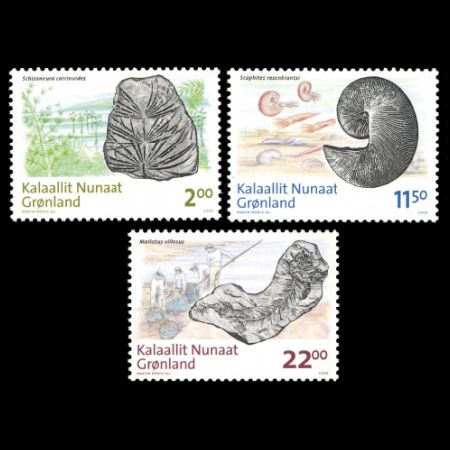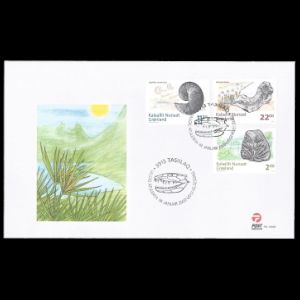Greenland 2009 "Fossils in Greenland (II)"
| <prev | back to index | next> |
| Issue Date | 19.01.2009 |
| ID | Michel: 529-531; Scott: 533-535; Stanley Gibbons: 568-570; Yvert et Tellier: 510; Category: pF |
| Design | Martin Mörck - illustrations and the engravings |
| Stamps in set | 3 |
| Value | DKK 2.00 - Schizoneura carcinoides DKK 11.50 - Scaphites rosenkrantzi DKK 22.00 - Mallotus villosus |
| Emission/Type | commemorative, |
| Issue places | Tasiilaq |
| Size (width x height) | 39.52 x 28.84 mm |
| Layout | 3 sheets of 40 stamps each |
| Products | FDC x1, MC x3 |
| Paper | TR4 |
| Perforation | 13,25 x 13,25 |
| Print Technique | Offset lithography and Recess |
| Printed by | POST Danmark |
| Quantity |
Schizoneura carcinoides: 111.970 Scaphites rosenkrantzi:119.347 Mallotus villosus: 102.853 |
| Issuing Authority | POST Greenland |

On January 19th, 2009, the Post Authority of Greenland issued the second of two stamp sets "Fossils of Greenland". The first set was issued in the previous year.
The illustrations and the engravings are made by the Norwegian Martin Mörck.
The following text was written by David Harper, professor in Paleontology at Copenhagen University and Bent Lindow a palaeontologist at the Natural History Museum of Denmark (University of Copenhagen). The text was published in "Greenland Collector" magazine in January 2009.
David Harper is Professor of Palaeontology, University of Copenhagen and is in charge of
the palaeontological collections in the Geology Department, Natural History Museum of
Denmark, University of Copenhagen.
He is also head of the Geology Research Group at the museum.
His research is field and specimen-based, focused on the Lower Paleozoic
rocks and fossils of Greenland, Scandinavia, the British Isles and China.
He is currently Chair of the Publications Board (Palaeontological Association), President
of the International Palaeontological Association and Chairman of the International Sub commission
on the Ordovician System.
Bent Lindow is a palaeontologist at the Natural History Museum of Denmark (University
of Copenhagen).
He studies the evolution of birds and how it was influenced by prehistoric climate change.
Bent has given numerous lectures and participated in radio- and
TV-interviews on palaeontology and the evolution of life in Denmark and abroad.
This is the second and final part of Post Greenland’s series about fossils in Greenland and consists of three stamps demonstrating aspects of the extensive and exciting fossil record of Greenland.
The second group of images continues our journey through some of the key events in the history of life on our planet, beautifully illustrated by yet more unique fossils.
These three fossils, a plant, an invertebrate and a vertebrate, are from the younger part of the fossil record, ranging from about 200 million to just some 8,000 years ago.
Schizoneura carcinoides.
One of the five big mass extinction events occurred some 200 million years ago at the boundary between the Triassic and Jurassic systems. Beautifully-preserved plant fossils have been known for many years from Jameson Land in East Greenland derived from ancient forests that survived this extinction event. The horsetail Schizoneura carcinoides, with its distinctive spiky leaves, grew in marshes and if present in sufficient numbers could generate coal. In East Greenland these plants were common near Scoresby Sound and were first described over 70 years ago. Now they are helping scientists assess climate change during the mass extinction event.
Scaphites rosenkrantzi
The end of the Cretaceous extinction, 65 million years ago, is better known since it is linked to a massive environmental catastrophe associated with the impact of a giant asteroid and major volcanic eruptions. During this period the dinosaurs and various types of giant marine reptiles, such as the mosasaurs and plesiosaurs, disappeared from Earth forever.
Another fossil group, the ammonites, similar to modern nautilus, became almost extinct with possibly only a couple of stragglers surviving into the Tertiary. During the later Cretaceous, however, the ammonites began to develop some fascinating and unusual shell shapes. Scaphites rosenkrantzi from the Cretaceous rocks of Nussuaq, West Greenland is a spectacular example, where the coiled shell of the animal has started to unravel. Despite its strange shape it could undoubtedly maintain its buoyancy in the water and probably swam quite fast.
Mallotus villosus or the capelin is a small smelly fish, common today in the Arctic seas, prized for its roe but also as a base for fish meal. The capelin, however, is also found as fossils in the Quaternary sediments of West Greenland, some nearly 8,000 years old, appearing identical to its living relatives. These fossils were brought to the attention of scientists in Europe more than 200 years ago by whalers, who probably collected them from localities such as the head of Sondre Stormfjord, where they are still common today.
Products and associated philatelic items
| FDC | First-Day-of-Issue Postmarks | |
 |
 |
|
| Skull of Ichthyostega stensioei shown on the postmark - the same design as the postmark of 2008 |
References

|
-
Technical details and brief stamps description:
Greenland Collector", vol. 14, No 1, January 2009
Acknowledgements:
Many thanks to Dr. Peter Voice from Department of Geological and Environmental Sciences, Western Michigan University, for the draft page review.
| <prev | back to index | next> |